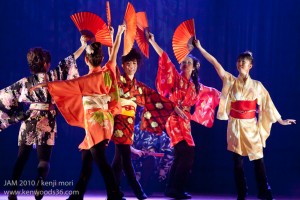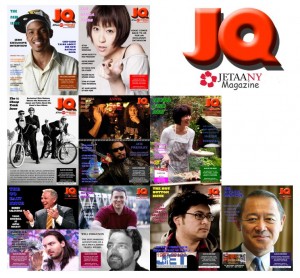Hibari-sensei: Interview with Mio Soul for Purple SKY
Jen Wang (Miyagi, 2008-09) is a lab tech in Dallas and a staff writer for the Japanese music website Purple SKY. Her love of cosplay and her junior high school students inspired the name for her own Japanese pop culture blog, Hibari-sensei’s Classroom.
Tokyo-born songwriter Mio Soul makes her debut with In My Skin. The EP contains the heavy drum beats and smooth melodies of contemporary R&B with flavors of pop, dance, and jazz. Simple yet candid, the lyrics are in English, except for the rap in “Let’s Party” where Mio effortlessly flows in and out of her native language. “Promise” chronicles Mio’s pursuit of her dreams in New York City and features sensual vocals complemented by airy piano trills. The final track, “Out of My Life”, takes a complete 180 from the sweetness of “I Wish” in the beginning. Mio engages an ex-lover in a showdown with passionate vocals and sexy Spanish guitars. Even though she sings that her “story’s ended” for that person, it has only just begun in the music world.
I had the opportunity to ask my fellow biologist via email about her career change, the “I Wish” PV, and her involvement with music-related charities.
 What made you change from being a biologist to a musician?
What made you change from being a biologist to a musician?
When it comes to biology, I had a huge influence from my father. My mom, however, is a pianist, so music was always around me as a child. In college I was so curious about the connection of brain function and soul (heart)…I enjoyed all of the field work. I did, however, want to do music more than anything else. I started performing more and attending singer and dancer showcases, and these live performances just really fueled me to continue pursuing music.
Science is a real academic thing. You use instruments and theories to find the truth. When it comes to music, singing or making beats is the art of using your own instrument (your body and soul) to express your truth.
Did you have any formal vocal training?
Yes, I had two amazing vocal coaches since moving to NYC: Stacey Penson and Jamelle Jones. The best vocal training was…wait, should I mention this secret? I can give a hint: it has to do with going to church on Sunday.
Click here to read the rest of the interview
JQ Magazine: JQ&A with Author/JET Alum David Namisato on ‘Life After the B.O.E. the Book’
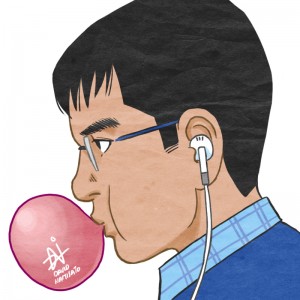
"The JET Programme mantra is “Every Situation is Different,” but so much of the frustrations and the joys that we encounter are very similar. I wanted a vehicle for us to laugh together." (Illustration courtesy of David Namisato)
By Rick Ambrosio (Ibaraki-ken, 2006-08) for JQ magazine. Rick manages the JET Alumni Association of New York (JETAANY)’s Twitter page and is the creator of the JETwit column Tadaima!
It’s probably happened to you over the last few years; you’re sitting at work, or maybe at home and an old buddy of yours from JET forwards you a link. You open it, and it’s a hilarious comic about life as a JET skillfully drawn with a mix of humor and nostalgia that pretty much makes your day. Life After the B.O.E. by David Namisato (Aomori-ken CIR, 2002-04) has given many a JET Alum a good laugh. If you’re anything like me, you’ve thought, “If this was a book, it would be a perfect Christmas present for those guys I still keep in contact with.” Well, David is happy to oblige.
David has now published a book of those comics, and we were lucky enough to catch up with him and pick his brain about it. With his comics popping up on other sites, it seems even a wider audience is getting into David’s work. In this exclusive interview, we ask him about his time on JET, his inspirations, and what he’s looking to do in the future.
What made you decide to publish this book?
I wasn’t planning to do a book initially, but a conversation with Lynn Miyauchi, JET Program Coordinator at the Consulate-General of Japan in Seattle, about the benefits of having a printed book (having something to read in your hands, something you can give as a gift) changed my mind.
So how did you get into art? Were you inspired at all by Japanese art/manga/etc.?
I drew a lot throughout childhood and dreamt of being a comic book artist. I grew up on a healthy diet of manga.
What brought you to Japan?
I was in the process of dropping out of animation school, and didn’t want to do anything art-related. I thought of some of the other skills I had, and I thought that the JET Programme would be an excellent way to transition myself in to a completely different career path.
Justin’s Japan: L’Arc~en~Ciel Marks 20 Years in Rock with Special Film Screening

'The Best of L'Arc~en~Ciel 2 Days Live at Tokyo Ajinomoto Stadium' premieres Nov. 29 in New York. (Courtesy of Live Viewing Japan)
By JQ magazine editor Justin Tedaldi (CIR Kobe-shi, 2001-02) for Examiner.com. Visit his page here for related stories.
After 20 years, 13 million albums and 16 million singles sold, famed J-rock group L’Arc~en~Ciel is ready for its next career highlight: New York City.
On Nov. 29, movie theaters in Times Square and Union Square will unveil a special one-night-only music event for the band, which will be simulcast in eight other major American cities. The screening comes months ahead of their hotly anticipated live debut at the Theater at Madison Square Garden in March 2012.
Entitled The Best of L’Arc~en~Ciel 2 Days Live at Tokyo Ajinomoto Stadium, the concert film celebrates the group’s 20th Anniversary, traces their colorful history, and captures them in action at a gig last year that drew over 100,000 fans. The screening is presented by Live Viewing Japan in partnership with Maverick DC Group.
Live Viewing Japan is a distribution company focused on bringing Japanese entertainment media to an international audience. In New York earlier this month, they screened a concert showcase by superstar virtual idol Hatsune Miku (read this Examiner’s review here), and L’Arc~en~Ciel’s film has already made the rounds in São Paulo, Jakarta, Singapore, and will beam its way to London next month.
For the complete story, click here.
Justin’s Japan: Theatre Review — ‘Kutsukake Tokijiro’ an Inspired Yakuza Yarn
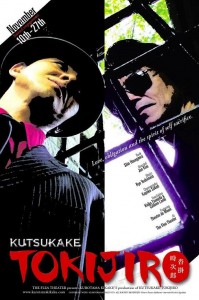
'Kutsukake Tokijiro' runs through Nov. 27 at New York's Flea Theatre. (Courtesy of Kurotama Kikaku Company)
By JQ magazine editor Justin Tedaldi (CIR Kobe-shi, 2001-02) for Examiner.com. Visit his page here for related stories.
Mounting a 1920s Japanese gangster play with J-pop flavored fillips may seem like a tough sell, but the new Off-Off-Broadway production of Kutsukake Tokijiro is a successful hybrid that should appeal to fans of “world” stage productions.
Opening last week at Tribeca’s Flea Theater and running through Nov. 27, Kutsukake Tokijiro (if you can pronounce it, you’ve probably already seen it) caps a nearly three-year journey to the stage by New York’s Kurotama Kikaku Company and its artistic director, Jun Kim. A native of Japan with Korean heritage, Kim is an actor, dancer, and director of the show, doing double duty in the opening scenes as Mutsuda-no-Sanzo, the target of the titular Tokijiro (played with noble gravitas by Yasu Suzuki).
If these names sound hoary, consider the source material: written by Shin Hasegawa in 1928, KT is a hallmark of Japanese popular theatre, based in turn upon on a 19th century Japanese Yakuza/lone gambler story cut almost from the same cloth as the Spaghetti Western. In its first-ever English translation by the venerable Keiko Tsuneda, KT is reborn for an American audience.
Kim’s vision for a 21st century KT is to inject Japanese pop culture animation and folk songs as well as the dance movements of Noh, Kabuki and contemporary dance to form a “J-pop Theatre.” This is achieved via Japanese-language scenes between Tokijiro and his rivals (English supertitles are helpfully flashed above center stage) and through his more tender moments with Sanzo’s widow, Okinu (Hiroko Yonekura), whom Tokijiro elopes with along with her young son Tarokichi (Asuka Morinaga).
For the rest of the article, click here.
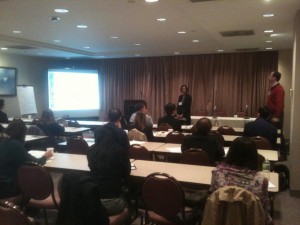
Amber Liang and Sean Harley explain the art of getting a job without ever asking (i.e., informational interviews). (Steven Horowitz)
By Carolyn Brooks (Ishikawa-ken, 2006-11) for JQ magazine. Carolyn is co-author of the blog MadSilence–a cross-cultural blog written with her father–and a current culture/education related job-seeker in the New York area available for full-time or consulting work.
JET alumni from all walks of life gathered this weekend at the Nippon Club in New York City to talk about something important to us all: jobs and how to get them. The Career Forum is a much-anticipated event, with JETAA New York providing a varied and well-planned series of presentations for recent returnees and new career searchers alike.
“We hold this event annually to help the recent returnees get settled back in New York, provide job hunting advice and techniques for highlighting the JET experience on their resume, and give them the opportunity to meet alumni and recruiters in their possible career fields,” said JETAANY president Monica Yuki (Saitama, 2002-04). The Career Forum achieved all those objectives with flying colors, as well as giving us recent returnees a taste of home, which for many of us suffering from reverse culture shock was as welcome as the career advice.
Evan Hyman (Osaka, 1995-96) started the presentations off with a bang, sharing the 10 most important lessons he’s learned in his 14 years since JET. Over the years he’s worked in marketing and planning with some of the world’s largest companies (including Pepperidge Farm and Johnson & Johnson), but that doesn’t mean he hasn’t encountered the same road bumps that new jobseekers do. Some of his advice included practical matters like “Network, network, network!”; “Utilize as many recruiters as you can”; and “Your job search will be determined by the economy”; but it was his more personal advice that really struck me.
Lesson #9 was “It can take a really long time to realize what you want to do.” Mr. Hyman’s had some jobs that, while lucrative and attractive, just weren’t for him. It was those jobs that helped him find his “sweet spot” and learn skills that got him the jobs he liked. No experience is ever wasted! Lesson #5, my personal favorite, was “Have a passion for what you do!” If you work at a job you’re not interested in, you’re not going to do your best work, so find your passion and see how you can use it in a career. Read More
Justin’s Japan: Film Review – ‘Hatsune Miku Live Party 2011 39’s Live in Sapporo’
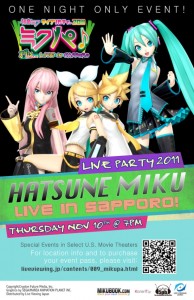
"With New York going bananas in between numbers and the room itself mimicking the Sapporo show with timed strobe and lighting effects—the theater’s management really went the extra mile—it truly felt like being at a concert." (Courtesy of Live Viewing Japan)
By JQ magazine editor Justin Tedaldi (CIR Kobe-shi, 2001-02) for Examiner.com. Visit his page here for related stories.
On Nov. 10 a one-time theatrical screening was held for a new concert film from virtual pop phenom Hatsune Miku. Entitled Hatsune Miku Live Party 2011 39’s Live in Sapporo, the film—captured in August at the 2,000 capacity Zepp Sapporo—is Miku’s latest appearance in America following a Toyota ad campaign and live gigs at L.A.’s Nokia Theatre and the San Diego Comic-Con earlier this year. (In fact, this reporter was interviewed for Japanese TV about that; click here for the news clip.)
Hatsune Miku, whose name means “first sound of the future,” is a Vocaloid (meaning machine-made vocals) digital female avatar and the most popular of Crypton Future Media characters that employ Yamaha technology to create synthesized vocal tracks, similar to Auto-Tune. In Japan, Miku is massively successful and has appeared in numerous popular video games and music videos, and her Sailor Moon-meets-Avril Lavigne image (she is a teen idol, after all) is equally fanboy and fangirl friendly.
Presented by Live Viewing Japan and simulcast in nine U.S. cities, this screening was shown to a capacity Times Square crowd. From the moment Miku’s name flashed up on the dark screen five seconds in, the audience was hooked. Wild applause, shrieks and excitement from the mostly American teens and twentysomethings in the crowd took the older folks by surprise. “This is like Paul McCartney to us,” remarked one lady several seats away. (She and her companion left about an hour in.)
For those unfamiliar with J-pop, the genre’s credo is style over substance (Katy Perry and Lady Gaga are our closest counterparts), but just like with our pop tarts, a catchy hook is a catchy hook. With a black, completely bare stage flanked by a five-piece band (yes, the music seems to be performed live), the only thing besides Miku noticeable throughout are the hundreds of lime green glow sticks pumped energetically by the fans throughout. Again, this was mirrored by the Times Square audience as one enterprising otaku passed out five blue ones (not to be outdone, he carried a massive Darth Maul-ish staff that lit up a chunk of the theater.)
For the rest of the article, click here.
A (Culturally) Stimulating Interview with the Insatiable Asa Akira

“I think I have a lot of Japanese culture ingrained in me. Just from being from a Japanese family, living in Japan. The whole ‘respect your elders,’ that, to me, is the main thing that’s different between America and Japan.”
Porn porn
By Michael Karns (CIR Kobe-shi, 2001-02) for JQ magazine. Michael is an avid photographer.
The winner of five AVN Awards (like the Oscars, but without Cuba Gooding, Jr.), Asa Akira returned to the East Coast last weekend for a rare promotional trip. In the spirit of intensifying relations between our nation and Japan, we spoke with the scintillating 25-year-old superstar/native New Yorker about her Japanese roots, her favorite anime films, and the deeper cultural points that America and Japan can swap with each other.
Regarding your Japanese heritage, where is your family originally from?
My mother’s side of the family is from Osaka and my father’s side is from Tokyo, but they live in Yokohama.
You went to an American school growing up.
I did, a very prestigious American private school. It was nice.
When Japanese students relocate to America, it can be difficult adjusting. How was it for you relearning the way of life here?
I was born in New York City and I moved to Japan when I was six, so I already had a little America experience, but it was definitely a huge culture shock. Kids in Japan are really good, even American ones. So coming to New York was like, “Oh my God, these kids are 12 years old and they’re doing drugs!” It was definitely a huge culture shock, and I totally bought into it for a little bit (laughs).
You’ve got an incredible personality…
Thank you.
What do you attribute this to?
I grew up around boys; I think that has a lot to do with my sense of humor. Me and this other girl were always the only two girls in this group of boys, so I think we grew up with a really good sense of humor, you know?
So are you kind of like an otemba (tomboy)?
Yeah (laughs).
That’s my type, by the way.
Oh, good (laughs).
Regarding Japanese culture, what things do you like the most about it? Are there any films or other things that you point to as an inspiration?
I think I have a lot of Japanese culture ingrained in me. Just from being from a Japanese family, living in Japan. The whole “respect your elders,” that, to me, is the main thing that’s different between America and Japan. People in America treat old people like [expletive].
I love my grandmother, but I know what you’re talking about.
(Laughs) And they just don’t listen to older people. I think that’s weird. So that would be the main thing.
By Sierra Soleil (Fukushima-ken, 2000-02) for JQ magazine. Sierra works at an ESL school in Manhattan. He enjoys teaching, writing, and riding his bike.
The first weekend of November marked the ninth annual Japan Arts Matsuri (JAM) in New York, this year at the Theater for the New City in the East Village. With about 30 volunteers and a handful of business sponsors, JAM put on an excellent show for roughly a thousand people over the three exciting days.
The entryway and lobby of the theater was crammed with tables selling everything from okashi and yakisoba to clothes and handicrafts, though most people in the know went directly for the Sendai miso cream puffs, and for good reason. There were even two carnival games: a simple one involving throwing a plastic katana at prizes, and an incomprehensible one where people poked little cookies with needles for some reason. Nearly every table was also raising money for earthquake/tsunami relief.
Every day of the three-day matsuri had music and dance performances, but Saturday was Talent Night, where performers could compete for a special invitation to perform at next year’s JAM. I wasn’t sure what to expect from Talent Night, which was good, because it was as wildly erratic as any cross-section of modern Japanese music and dance should be. The first act I caught was Robin’s Egg Blue, a cheerful acoustic pop group. They were followed by a band called Firesign, which was meant to be metal, though any spell they cast dissipated immediately when, as they left the stage, one of the emcees decided to reassure us that they were all very polite in person. After that there were modern and traditional dances, a gospel singer, a karaoke cover of Cee Lo Green’s smash hit (the “Forget You” version, of course), and a fascinating collaboration between a belly dancer and a beatboxer.
The show was billed as being like Amateur Night at the Apollo, and there was some resemblance. The acts were short, and before each intermission the audience chose their favorite via applause. Looking at the lineup, it occurred to me that JAM’s offering was a lot more diverse than anything I’ve seen at Amateur Night. One of the matsuri’s goals is to share Japanese culture with Americans, and the lesson to take from Talent Night is that culturally, the Japanese really are into everything. It also occurred to me that the power to vote by cheering for a performer we liked meant a lot less without the power to impeach them by booing.
I came to Talent Night specifically to meet with JET alumna Kirsten Phillips (Niigata-ken, 2005-08), a member of the Yosakoi Dance Project 10tecomai. The first impression she makes is everything a JET is supposed to be: energetic, cheerful, with a kind of wide-eyed enunciation that makes everything sound exciting. She went directly from teaching in Japan to teaching special education in New York, and it immediately seems like she would be good at it.
JQ Magazine: Film Review – Sion Sono’s ‘Cold Fish’ an Antisocially Acquired Taste

“In the end, Sono really does ask us about our humanity, and what life is about. Sure, he takes the bloody, abusive, rape-filled path, but he does touch on some solid stuff. It’s a lot of big questions wrapped in a gory, misogynistic, boob-exposing gift box.” (Courtesy Salient Media)
By Rick Ambrosio (Ibaraki-ken, 2006-08) for JQ magazine. Rick manages the JET Alumni Association of New York (JETAANY)’s Twitter page and is the creator of the JETwit column Tadaima!
I was hungry, real hungry after work and was about 20 minutes early to the New York Museum of Art and Design near Columbus Circle to see the movie Cold Fish 「冷たい熱帯魚」, so I walked a block to Good Burger and grabbed an overpriced hamburger. As I arrived back to the museum, I sat next to Shree (name changed to protect the innocent) who was midway through a burrito. With minutes left before the movie started, we headed into the museum and down some wooden steps to the theater. Walking in I was pretty surprised; we were only accompanied by seven or eight other patrons. Little did I know that it was a blessing in disguise…fewer people to feel awkward around after the movie.
Oh yes, the movie. How do I write about Cold Fish? It’s a little difficult. I suppose I can do it like this:
Cold Fish is a film directed by the controversial Sion Sono (whose month-long, eight-film retrospective wraps this week at MAD) and stars Denden and Mitsuru Fukikoshi. The film is based on real murders that took place in Fukushima. The story begins well enough: A timid man named Nobuyuki (Mitsuru Fukikoshi) with a rebellious daughter (Hiraki Kajiwara) and a hot trophy wife (gravure idol Megumi Kagurazaka) is feeling disconnected and regretful. They own a tropical fish shop. Through an awkward circumstance they meet Mr. Murata (Denden) and his attractive wife (Asuka Kurosawa), both of whom also own a tropical fish shop.
From there, shit just gets weird. That’s the only way I can explain it, folks. And it wasn’t just because the film cut out four times while we watched it. (Apparently, there were Blu-ray issues…through most of the movie. The museum might want to buy a new player before they hold another festival.) Anyway, Mr. Murata decides to bring Nobuyuki on as a partner, but not before hiring his daughter at his shop and sleeping with his wife (who apparently enjoys rough treatment, to put it mildly).
As Nobuyuki is introduced as the new partner, the old partner finds himself exiting the business via a poisonous death. This is where things kick into the next gear, and Murata forces Nobuyuki to assist with the disposal of the body. The whole body disposal process is presented with great detail. I’m serious about this part—after watching this movie, I am fairly confident that anyone could make a dead body disappear.
The plot then dives deeper and deeper into the dark comedy that is Murata’s utter disregard for human life and the director’s utter disregard for your stomach. By the way, did I mention that this film is very graphically violent? If you aren’t into that kind of thing, find another show; this movie revels in its ability to test what you can deal with gore-wise. If you enjoy severed heads and genitalia being tossed around a bathroom, you’ve found your dream movie.
Hibari-sensei: THE LAST DAYBREAK by exist†trace
Jen Wang (Miyagi, 2008-09) is a lab tech in Dallas and a staff writer for the Japanese music website Purple SKY. Her love of cosplay and her junior high school students inspired the name for her own Japanese pop culture blog, Hibari-sensei’s Classroom.
Recently I wrote a review of THE LAST DAYBREAK, the latest EP by exist†trace, for Purple SKY. The all-female J-rock band made their major label debut this past June and are now gearing up for a U.S. tour. They will play in Boston, New York, and Philadelphia, as well as Tekkoshocon in Pittsburg, in March.

THE LAST DAYBREAK opens with a primal call from Jyou, but instead of singing in her trademark growling alto, she keeps her voice light and clear in “Daybreak ~Jyusan gatsu no shikisai.” Unexpected moves like these are the highlight of exist†trace’s new album.
Read the rest of the review here.
Justin’s Japan: Japan Arts Matsuri 2011 presents amateur night, guest stars, charity showcase
By JQ magazine editor Justin Tedaldi (CIR Kobe-shi, 2001-02) for Examiner.com. Visit his page here for related stories.
For every Japanese artist and entertainer in New York with a dream to make it big, the ninth annual Japan Art Matsuri (JAM) is the place for their star to shine. Held this year from Nov. 4-6 at the Theater for the New Cityin Manhattan’s East Village, this year JAM 2011 offers its biggest and most diverse lineup to date.
Hosted by Yoshi Amao and Saori Goda and presented by JaNet in association with Faune Dance Troupe, JAM 2011 has established itself as one of America’s largest Japanese art and music festivals, presenting Japan and its unique culture with performances by Japanese artists, musicians and entertainers in a true matsuri (festival)-style atmosphere, and to enhance friendship and communication among New York City’s cultural communities.
More than 1,000 people are expected to attend the three-day event that features, in addition to live entertainment, a variety of street stall-style shops in the theater lobby that sell everything from Japanese food and drinks to artworks and traditional goods. There will also be charity booths to help those in Japan devastated by the 3/11 Tohoku earthquake and tsunami disaster.
For the complete story, click here.
JQ Magazine: Concert Review – DREAMS COME TRUE in New York City
By David A. in Virginia, special to JQ magazine.
Japanese mega-band DREAMS COME TRUE (ドリームズ・カム・トゥルー a.k.a. ドリカム) made a very rare U.S. appearance at the Highline Ballroom in New York City on October 9, the first of two shows that sold out within days of their announcement in July. Many thanks to fanpage DCT Joy for notifying its members of this wonderful event. For those of us not in New York, Los Angeles, or Seattle, we otherwise might not have known about it.
At dusk, around 6:30, the line already was down the block for admission to the inconspicuous Highline Ballroom in Chelsea. On this unseasonably warm October Sunday evening, the anticipation was palpable, the “DCT Joy” bringing alive the night. One walks upstairs to the ballroom, spare and easy to navigate. The management asks those seated on the floor of the “pit” to stand so that the crowd can fill the room.
First of all, a big shout-out to Justin Tedaldi (Kobe-Shi CIR, 2001-02) at JQ magazine. This reviewer cannot thank you enough. Also, thanks to Reiko from the DCT organization for her kind words.
Prior to the show, the house PA played a recording of some of DCT’s most well-known melodies, such as “Ano Natsu no Hanabi” and “Ureshii! Tanoshii! Daisuki!”, performed on soft bells.
Promptly at 8:00, introductions were made first by a woman in Japanese, to great enthusiasm from the audience; then a man said, “New York City! Are you ready for DREAMS COME TRUE?!” “A theme of the WONDERLAND” played as the fifteen-piece band-and-dance ensemble walked on stage, followed by Masato Nakamura (中村 正人). Although the Highline Ballroom has a standing capacity of 700, with a few dozen dinner tables on the balcony, the roar from the crowd was as if they were in an arena. With the theme concluded, Miwa Yoshida (吉田 美和) arrived, with her hair tied back and wearing a loose-fitting, light pink outfit; and, with her familiar exclamation “DREAMS COME TRUE in WONDERLAND….!!!”, the band launched into a heavy version of “Nando Demo,” as the crowd danced, waved, and cheered, encouraged by Miwa in all of her boundless energy.
JET Alumni cited in U.S. Deputy Secretary of State’s Speech at Todai
Thanks a bunch to JETAA Music City Treasurer Jennifer Butler (who also works at the Consulate in Nashville) for passing this along:
U.S. Deputy Secretary of State William Burns recently gave a speech at Tokyo University titled, “The Enduring Value of the U.S.-Japan Alliance“ in which he cited the value and contributions of the JET alumni and the JET Programme.
Here are the key excerpts:
“More than 35,000 people have now taken part in exchange programs sponsored by our governments — programs like the Fulbright Scholarship, the Mansfield Fellowship, and the Japan Exchange and Teaching Program, or JET. Exchanges between our government officials also play a key role in fostering mutual understanding. ”
“We are reaching out to ensure that younger Japanese business leaders understand the value of employees who know both of our cultures. We are calling on our own American JET alumni network to convince more students to study in America.”
Note: I know what you U.S. JET alumni are thinking. You have not yet received your call from the State Department personally asking you to get out there and convince more Japanese students to study in the U.S. All I can say is hang tight. And in the meanwhile, I guess we’re all now aware of one Return on JET-vestment thing we can do to help with the future existence of JET.
**************
Here’s the full text of the speech:
Remarks
Deputy Secretary
Thank you for the generous introduction, Professor Kitaoka and your warm welcome. It is truly an honor to be here today at Tokyo University. Read More
Miyagi JET alums organize Hong Kong fundraiser
******************
Thanks to Osaka JET Cailin Arena for letting us know about this:
From Miyagi JET alum Monique Moloney: “Here is the press release (and photos) for the fundraiser in Hong Kong on April 16. It was a great way to connect with the Japanese community in Hong Kong and to put our energy towards a positive outcome for Miyagi.”
********************
FOR IMMEDIATE RELEASE
Former Miyagi Residents Raise Funds Through Hong Kong Event
Hong Kong – 25th April, 2011
Two former residents of Miyagi Prefecture have pooled the creative expertise of five photographers in a silent photographic auction in Hong Kong to raise money for the March 11 earthquake and tsunami relief efforts.
The event entitled “Kampai for Sendai” was held on Saturday, April 16 at Shore Restaurant and Bar and was attended by approximately 180 people. The silent auction of distinctly Japanese photographs including 13 original mounts and three canvassed photographs, was the main focus of the evening. Additional funds were raised through the live auction of Simone Legno autographed Tokidoki merchandise and the sale of raffle tickets.
The total amount raised from the event was HK$30697 (US$3950). 100% of these funds were be donated to Peace Winds Japan andShine Humanity, two non-government organisations that have been highly visible in Miyagi Prefecture and are committed to using all designated funds for the Japan relief effort.
The event organizers, Monique Moloney and Matt Jones, both Australian nationals living in Hong Kong, were Assistant Language Teachers on the JET Programme in Miyagi Prefecture between 2003-2006. Having maintained strong connections with their former home, they were deeply affected by the devastation and suffering in communities where they’d often visited and fondly remembered. Their reaction was to organise an event that could raise awareness and funds in a meaningful way.
Through online groups, Monique found photographers who were willing to contribute their work to the cause. She also connected with other former JET participants who were living in Hong Kong. These people helped promote the event and attended to show their support.
“We may have moved on but we haven’t forgotten our friends in Miyagi Prefecture. It was our turn to give back for the kindness and good will we were shown during our time there.”
For more information, please contact Monique Moloney at mnqmlny@gmail.com or phone +852 90300243
JQ Magazine Is Looking for Writers for Fall 2011!
As the year winds down, JETAA New York’s JQ magazine continues to provide weekly content with an ever-expanding array of articles, interviews and features (for our recent stories, click here). Following our quarterly meeting in Manhattan this week, we’re now looking for new writers from all JETAA chapters worldwide to write and share more material that we can post online to the widest JET readership on the web through our hosts at the global JET alumni resource site JETwit.com.
Below are story ideas grouped by JET participants and alumni (JET World) and those more on Japanese culture (Japan World). If you’re a JET or JETWit contributor from anywhere in the world, we welcome your interest or extra story ideas! Contact JQ’s editor Justin Tedaldi (magazine [at] jetaany [dot] org) to sign up.
***JET WORLD***
JETAANY CAREER FORUM/WELCOME BACK RECEPTION (11/12)
We would like coverage of upcoming events in New York for any writers planning to attend.
JETs ‘RETURN TO TOHOKU’ SERIES
The Ministry of Foreign Affairs and the Japan Tourism Agency jointly organized an Invitation Program for JET Alums who worked as a JET in Iwate, Miyagi, Fukushima or Sendai-shi for 2 or more years to return to Japan as an ambassador. The goal of the program is to help promote the affected areas and do PR work on their behalf. From around the world, 14 JET alums were selected to return to Japan. Of those, eight were US JET alums. Visit the provided link to see their stories if you would be interested in doing a Q&A with one of them. Also, if you or other JETs are planning to return to help out in the wake of the devastation, we’d love to run an article so you can share your thoughts with other JETs around the world. www.jetaausa.com/tohoku-recovery/jet-alums-return-to-tohoku
‘ALONE IN THE KITCHEN WITH A RICE COOKER’ SERIES
We are running a new series on JETwit about solo cooking experiences while on JET (check out “Nattode,” the first piece in the series). Did you discover a new favorite comfort food in Japan, learn to cook a mouthwatering meal that you still serve today or accidentally buy something really weird only to discover (and reluctantly) eat it in your mansion? We want to hear about it!
HOLIDAYS IN JAPAN ANECDOTES WANTED!
This year, we’re bringing back seasonal holiday (from November through New Year’s) anecdotes from JET alumni around the world! If you have a strange, delightful (or both—we all do) short story to share about your holiday seasons past in Japan, we’d love to publish it.


